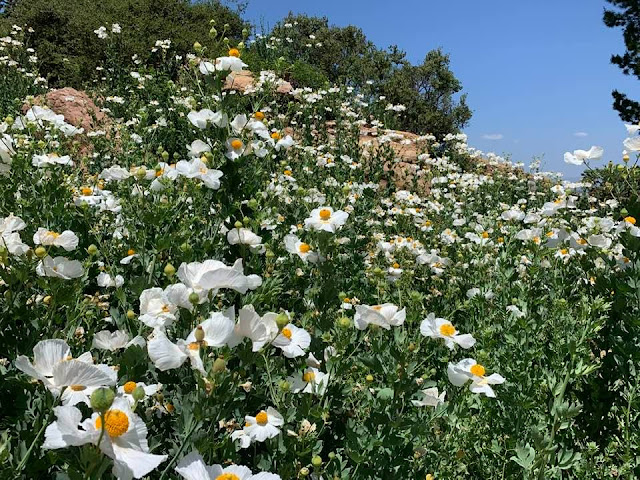Grindelia stricta var. platyphylla is a good strong dependable groundcover for Southern California Gardens. An assortment of bees, syrphid flies, moths, and butterflies find a valuable source of pollen and nectar in the attractive large yellow daisy flowers. This is a long-blooming plant in my garden. It starts blooming in early July and continues through the summer into the fall.
Grindelia stricta var. platyphylla S. Reeve
There are three forms of Grindelia stricta and they sort by size of the phyllaries, the size and shape of the leaves, where they occur, and their habit. These are all coastal plants in the state of California. Grindelia stricta var. stricta is generally found in Northern California. Grindelia stricta var. angustifolia is found in the San Francisco Bay Area. Grindelia stricta var. platyphylla (Greene) M.A. Lane is primarily found along the southern coast and in the Channel Islands.
Of the three, Grindelia stricta var. platyphylla, is the most garden-worthy because of its habit and appearance. This is a long-blooming plant, but it is also very attractive and dense even when not in flower. In this variety, the dark green leaves are larger and spatulate becoming more congested with smaller internodes at stem ends. This gives the plant a full habit that chokes out most weeds.
Grindelia stricta var. platyphylla Leaves at stem ends S. Reeve
 |
| Grindelia stricta var. platyphylla groundcover S. Reeve |
Grindelia stricta var. platyphylla phyllaries S. Reeve
The common name of this plant is the Dune Gumplant. It is so named because of the resin or gum that the phyllaries produce before the blower bud is mature. Numerous phyllaries have a unique reflexed shape that is very interesting. The upper part of the flower bud develops a sticky pool of glistening resin that discourages herbivory. As the bud matures and starts to open the gum is no longer in evidence, and reveals the sunshine yellow flowers to garden pollinators. You can see the "gum" in the bud more clearly in the photo below. This secretion really slows down the Argentine ants which is great!
Resinous gum in the bud of Grindelia stricta var. platyphylla Dee Warenycia
In the plants I have observed the amount of gum, and the size and shape of leaves vary. The plants I have do not make much resin. There are a couple of prostrate forms chosen for their superior garden traits. One is called 'Mendocino' and it was selected for its prostrate habit and larger flowers. The second is carried by San Marcos Growers and Suncrest and called 'Ray's Carpet'. It was selected and named for Ray Walsh who collected it in the 1980s. It was introduced by Santa Barbara Botanic Garden. My plants are from Las Pilitas Nursery and are not selections but they are still very pleasing and garden-worthy.
I grow this plant primarily for the large number and assortment of pollinators it attracts. It is one of the best plants for pollinators because the large ray-and-disk flowers provide a large landing platform for so many insects, even comparatively large, bumblebees use this plant. Many bee genera visit this plant including Halictids, Megachilids, Melissodes, honey bees, and Bombus. Several species of butterflies and skippers are attracted to this plant, including the small butterflies, Painted lady (Vanessa cardui), American painted lady (Vanessa virginiensis), West Coast lady (Vanessa annabella), Buckeye (Junonia coenia), and it is also a favorite of the Great Copper (Lycaena xanthoides). Moths nectar on it at night including Orange Tortrix (Argyrotaenia Franciscana), Oidaematophorus occidentalis, and Cremastobombycia grindeliella. The long bloom time makes it dependable for pollinators too.
The plant tends to spread widely by rooting at internodes or by infrequent seeding. I have picked up individual stems and followed them back and I didn't notice much rooting. In my garden, the plant just seems to grow outward at a steady rate. It is easy to keep it smaller if you want. Larger patches make it more visible for bees so keeping it at least a square meter in size is best. I haven't noticed it spreading by seed, it is possible it does, but it is well-behaved. One of the patches I have is about four feet by five feet in maybe six years. I hope to find rooted stems so I can move it to other locations.
Presently, it is blooming next to Salvia clevelandii 'Winifred Gilman', Iris douglasiana, and Scrophularia californica. I would like to try it in a large sunny area with other low-growing natives and non-natives that tolerate a little summer water in a quasi-meadow situation. I would like to mix it with Gaillardia, native Iris, Sidalcea, Erigeron glaucus, Zauschneria 'Everett's Choice', low-growing Salvia, Eriogonum grande-rubescens, Penstemon 'Margarita Bop', Senecio palmeri 'Silver and Gold', Lessingia filaginafolia 'Silver Carpet', and native clumping grasses. This plant can also be grown as a "spiller" over a low wall. If you have deer, they don't particularly like this plant because the leaves are rather coarse and can be sharply toothed.
I wouldn't be without this plant as it is one of the best plants for pollinators in the summer. Grindelia stricta platyphylla is a beautiful, low maintenance, and drought-tolerant plant perfect for your native wildlife garden.




















